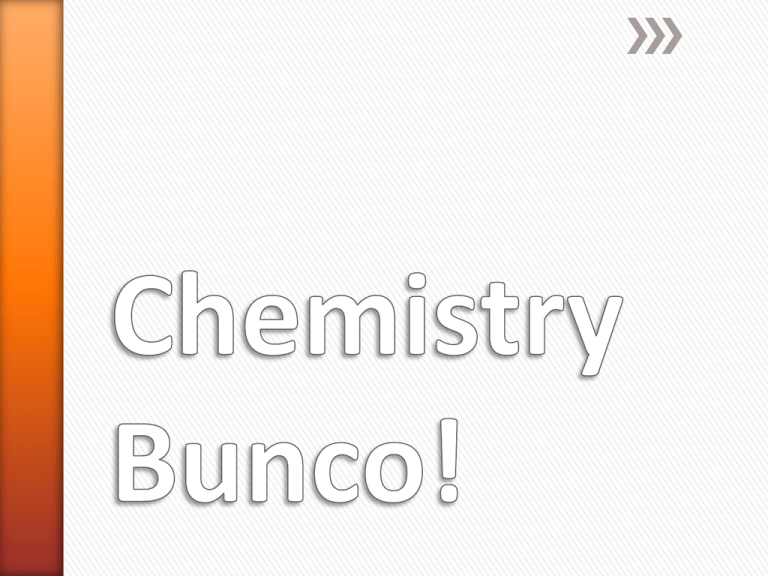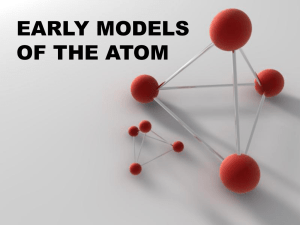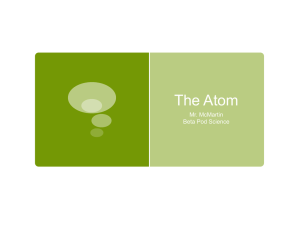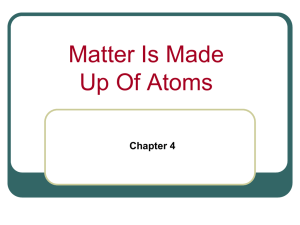powerpoint
advertisement

» What is the name of this device? » Which scientist used this device? »Cathode Ray tube »JJ Thomson »What experiment did Millikan do and what was one of his conclusions? Oil Drop Experiment Determined the mass of an electron (1/2000th the mass of H atom) Determined the charge on the electron (negative) »What experiment did Rutherford do and describe it? » Rutherford did the gold foil experiment » Bombarded a thin piece of gold foil with fast moving positively charged alpha particles » Expected the alpha particles to pass straight through. Most did, but 1 in 8000 were deflected back. »Complete the table for the main subatomic particles. Particle Relative Charge Mass Number Location in atom Proton Neutron Electron +1 0 -1 1 1 0 nucleus nucleus Outside nucleus »State 3 observations that Rutherford made (what did he see) and 3 conclusions he made from those observations. 1.Most of the alpha particles passed straight through the foil – atom is mostly empty space 2.1 in 8000 particles bounced back – atom has a very tiny, dense nucleus 3.Some alpha particles deflected – nucleus has a positive charge b/c positive alpha particles are repelled »What does the atomic number represent? »The number of protons in the nucleus of each atom of that element »What does the mass number represent? »The number of protons + neutrons in the nucleus »Define isotope »Atoms of the same element that have different masses »How do nuclides of the same element differ from each other (be specific)? »The have a different number of neutrons »Write the nuclear symbol and hyphen notation for the nuclide that has 2 protons and 2 neutrons. 4 »Helium-4 He 2 »Define atom »The smallest particle of an element that retains the chemical properties of that element »What nuclide is used as the standard in the relative scale for atomic masses? »What is its assigned atomic mass? Carbon-12 12 amu »What is the definition of the mole? The amount of particles equal to the number of atoms in exactly 12 g of Carbon-12 »How many particles are in one mole? 23 6.022x10 »What is the name given to the number of particles in one mole? Avogadro’s number »Calculate the average atomic mass of argon to 2 decimal places give the following isotopes: »Argon-36 (35.97amu; 0.337%) »Argon-38 (37.96amu; 0.063%) »Argon-40 (39.96amu; 99.600%) 39.95 amu »Naturally occurring boron is 80.20% boron-11 (11.01amu) and 19.80% of another isotope. The average atomic mass of boron is 10.81amu. What must the atomic mass of the second isotope be? 10.01 amu »How many atoms are in 6.755 mol Pb? 4.068x1024 atoms »How many atoms are in 0.250 mol Si? 1.51x1023 atoms »What is the mass in 23 grams of 3.011x10 atoms F? 9.499 g »What is the mass in grams of 25 atoms W? 7.6x10-21 g »Determine the number of atoms in 1.50g K. 2.31x1022 atoms »Determine the number of atoms in 0.02550 g Pt. 7.872x1019 atoms »Write the nuclear symbol and hyphen notation for the nuclide that has 6 protons and 8 neutrons. 14 »Carbon-14 6 C »How many isotopes does hydrogen have? Describe them. »Protium – 1 proton, 0 neutrons, 1 electron (most common) »Deuterium – 1 proton, 1 neutron, 1 electron »Tritium – 1 proton, 2 neutrons, 2 electron (radioactive) »What forces holds the nuclear particles together in the nucleus? »Nuclear forces »How did Dalton’s theory explain the law of conservation of mass? »Chemical reactions involve the rearrangement of atoms, but atoms are not subdivided, created or destroyed. »How many protons, electrons, and neutrons are there in an atom of chlorine-37? + 0 »17p ; 17e ; 20n »How many protons, electrons, and neutrons are there in an atom of bromine-80? + 0 »35p ; 35e ; 45n »Write the hyphen notation for the element that contains 15 electrons and 15 neutrons. »Phosphorous-30 »What is an amu? »1/12 the mass of a carbon-12 atom »Atomic mass unit »What is the mass in grams of 3.50 mol of the element copper? »222 g of Cu »The atomic mass of Tungsten is 83.84amu. What is the molar mass of Tungsten? »83.84 g/mol »How many atoms are in 132.90543g of Cesium? 23 »6.022x10 atoms of Cs »How many moles of calcium are in 5.00g of calcium? »0.125 mol Ca »How many atoms of lead are in 52.7g of lead? 23 »1.53x10 atoms of Pb »How many neutrons does uranium 238 have? »146 neutrons »How many protons does osmium-190 have? »76 »What is the name of the nuclide that has 22 protons and 25 neutrons? »Titanium-47 »Write the nuclear symbol for the isotope of sodium with mass 23 23Na 11 »A student finds that 15.20g of nitrogen will react with 17.37g, 34.74g, or 43.43g of oxygen to form three different compounds. This is an example of which law? Law of Multiple Proportions »State the 5 points of Dalton’s atomic theory 1. All matter is composed of atoms 2. Atoms of a given element are identical in size, mass, and other properties 3. Atoms cannot be subdivided, created, or destroyed 4. Atoms of different elements combine in simple whole-number ratios to form chemical compounds 5. In chemical reactions, atoms are combined, separated, or rearranged. »Which aspects of Dalton’s atomic theory were incorrect? Atoms cannot be subdivided – we know atoms are made of protons, neutrons & electrons. Atoms of a given element are identical in size, mass… - we know isotopes exist »Describe 4 properties of electrons that were determined based on the experiments of Thomson and Millikan. 1.Electron is negatively charged th 2.Has a mass of 1/2000 of H atom 3.Has a fixed charge to mass ratio 4.Present in atoms of all elements











